After nine trips to Greece in my lifetime; involving 12 islands, countless ferries and several bottles of Mythos Beer, I would estimate I have spent approximately 5 months in total in this amazing country! I KNOW Greece and want you to get to know (and love) it as well.
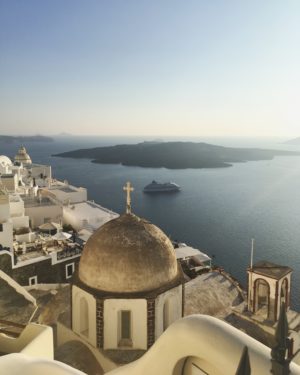
The incredible island of Santorini! (source – Pulped Travel)
I am a bit biased about Greece. Why? My paternal Grandmother lived in the capital, Athens, for much of her early life, so Greece is in my blood. From a young age, I was exposed to Greek food with dyed-red eggs at Easter as well as the syrupy dessert kataifi, alongside its language and culture and many of its traditions. I have also been in earshot of several loud and energetic telephone conversations my Grandma would have with her Greek friends as well as the constant reminders from her that, “the Greeks invented EVERYTHING!” So, by my very nature and upbringing, I am hard-wired to love Greece. There’s no denying the country that gave us the gods of Greek mythology is one magical place; however, I want to show you what I think is a very special part of Greece…the islands of the Cyclades!
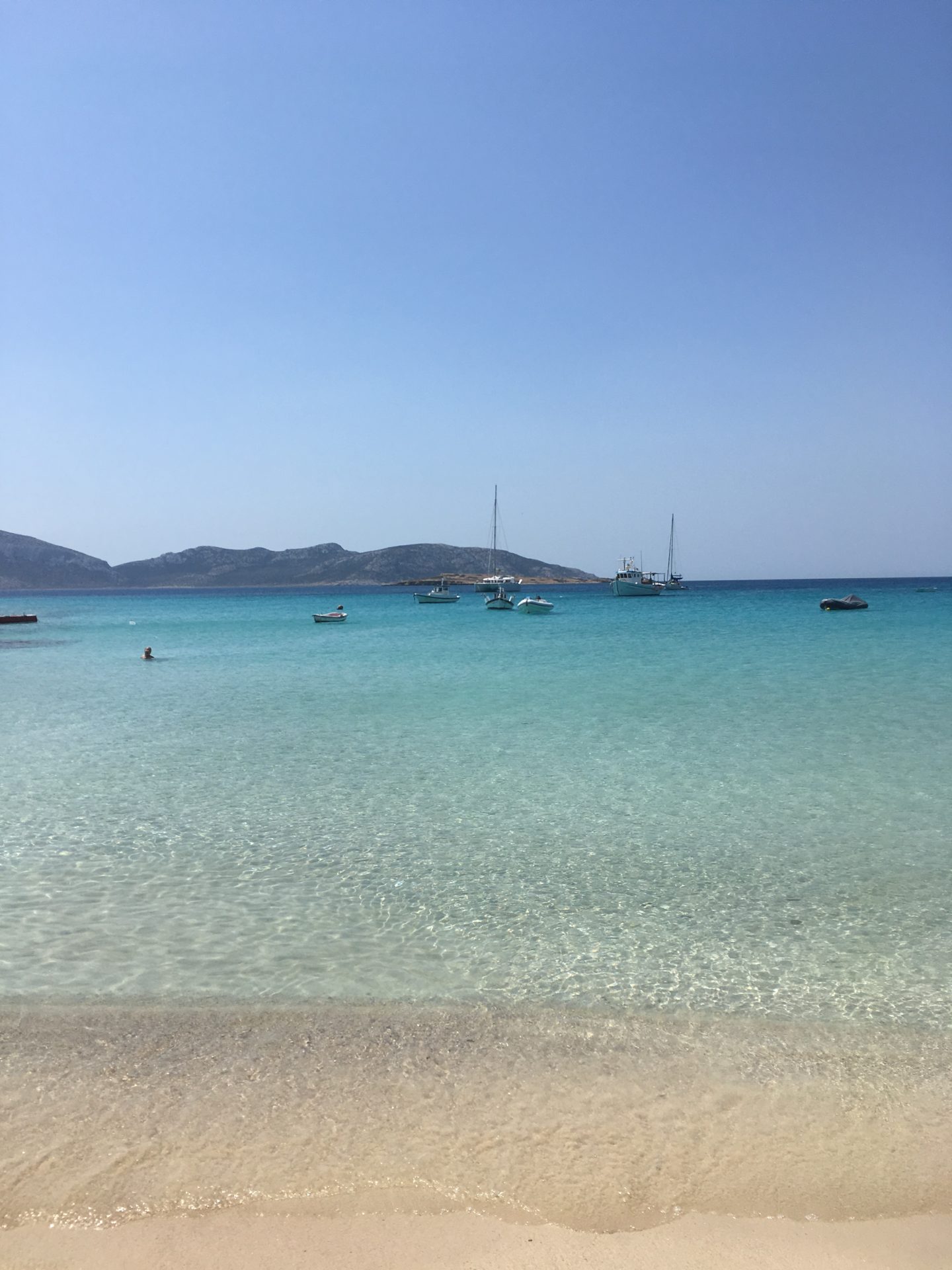
Koufonisia (source – Pulped Travel)
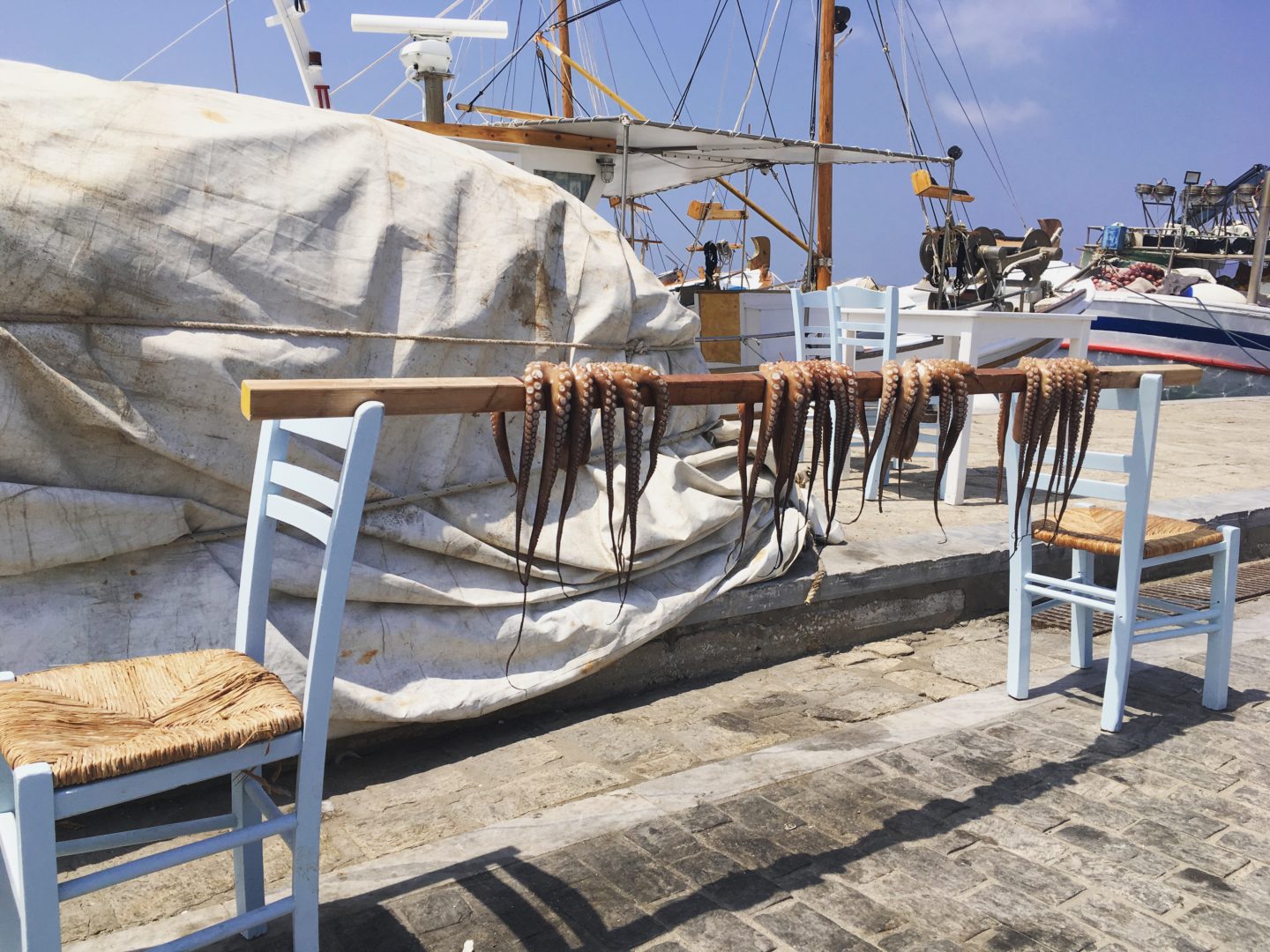
Paros (source – Pulped Travel)
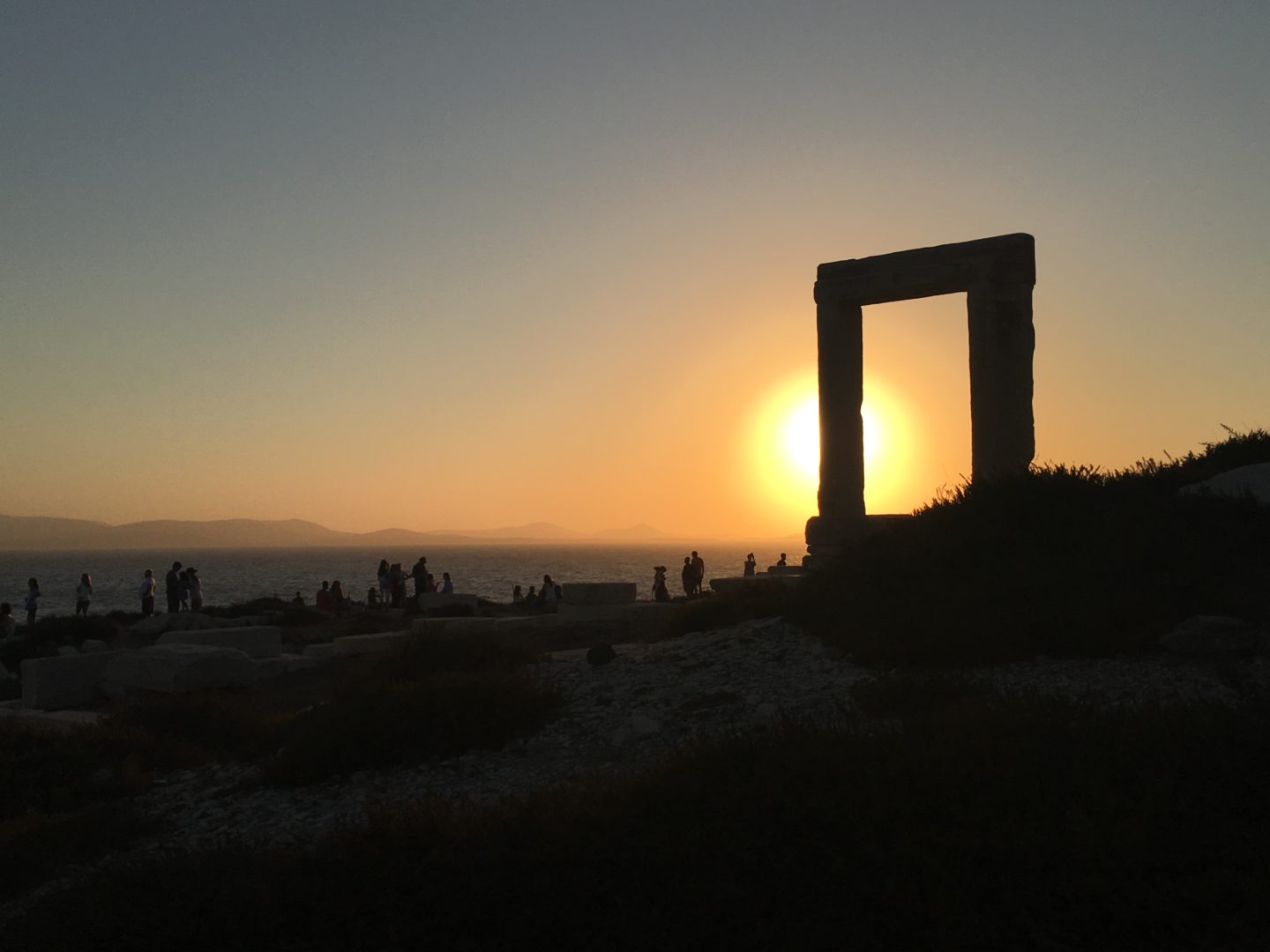
Naxos (source – Pulped Travel)
In this first article of seven (with six more Cyclades island-focused guides to follow), I will use my extensive expertise about Greece to provide you with a practical guide on how to get to the Cyclades and explain how to make your visit as easy and enjoyable as possible! And, as always at Pulped Travel, I will help you save time and money along the way!
WHEN TO GO?
The Cyclades, like much of Greece, follows three tourist seasons – low, mid and high season.
The LOW SEASON runs from spring to early summer (mid-April to mid-June) and also in the autumn (late September to mid October). Here you will find prices are cheapest for flights, accommodation and activities. You will also find the Cyclades at their quietest during the tourist season. Temperatures are also much lower than the high heat of the Greek summers.
The MID SEASON runs from mid-June to mid-July and then from mid-September to late September. Prices will be a little higher than the low season, but not as expensive as those in the high season. The mid-season also benefits from a quieter, slower pace of life than the high season and warm summer temperatures than the low season.
The HIGH SEASON runs from mid-July to early September. This is the Cyclades at its busiest during the peak summer period with prices at their highest and some scorching summer temperatures. One saving grace visiting the Cyclades during this, the hottest season, is the Meltemi wind; a north wind that brings a strong dry breeze that helps to cool the islands and provides excellent opportunities for windsurfing and wakeboarding. Though, it can be problematic for sailors and may, on rare occasions, lead to the cancellation of the inter-island ferries that connect the Cyclades.
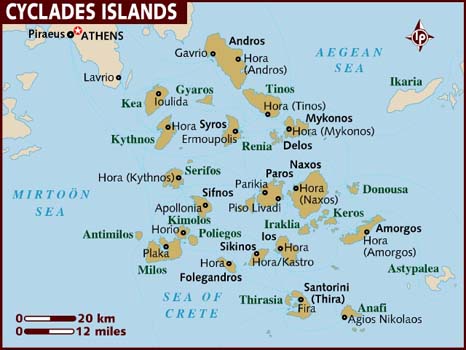
The Cyclades (source – Lonely Planet)
GETTING THERE
The Cyclades are made up of about 220 islands spread across the Aegean Sea; the most popular of which are Mykonos and Santorini followed by the islands of Naxos and Paros. Mykonos and Santorini both have international flights and are easily accessible from most major European cities via a number of popular airlines operating there on a seasonal basis including easyJet, British Airways, Aegean Airlines, Eurowings, SAS and Austrian Airlines. Connecting from further afield will usually require a flight to Athens and then getting to the islands via a ferry from the ports of Piraeus or Rafina or a domestic flight from the capital to Mykonos, Santorini, Naxos or Paros. As part of their summer 2018 schedule, Qatar Airways launched direct flights to Mykonos, for the first time, from their base in Doha; therefore, allowing for easier and quicker connections via their network of flights to over 80 countries across the globe.
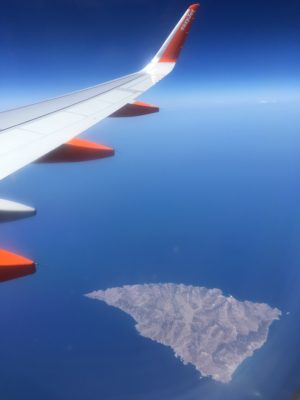
Arrival! (source – Pulped Travel)
Arriving at Athens International Airport will (as mentioned above) necessitate a domestic flight or a ferry journey from the two major ports – Piraeus or Rafina in order to reach the Cyclades. The closest port to the airport is Rafina, a 30 minute taxi ride north of the city. And although it is much less congested with vehicles and people than Piraeus, it is however limited in the range of ferries that depart from there. To reach the port of Piraeus, with its wider choice of ferry departures, will mean that you have to make the longer journey south-west of the city and face the crowds arriving and departing Athens at Greece’s busiest port. If a stay in Athens is part of your trip to the Cyclades, I would recommend using Piraeus for the choice that it offers across a number of operators and the savings that come with so much competition for business in one place.
TRANSPORT
FERRIES
Getting between the islands is made very easy by the abundance of inter-island ferries that serve the Cyclades. The Greek ferry timetable is usually released around January detailing schedules for that year. They can be found on the Greek Ferry Schedules page at the Visit Greece website.
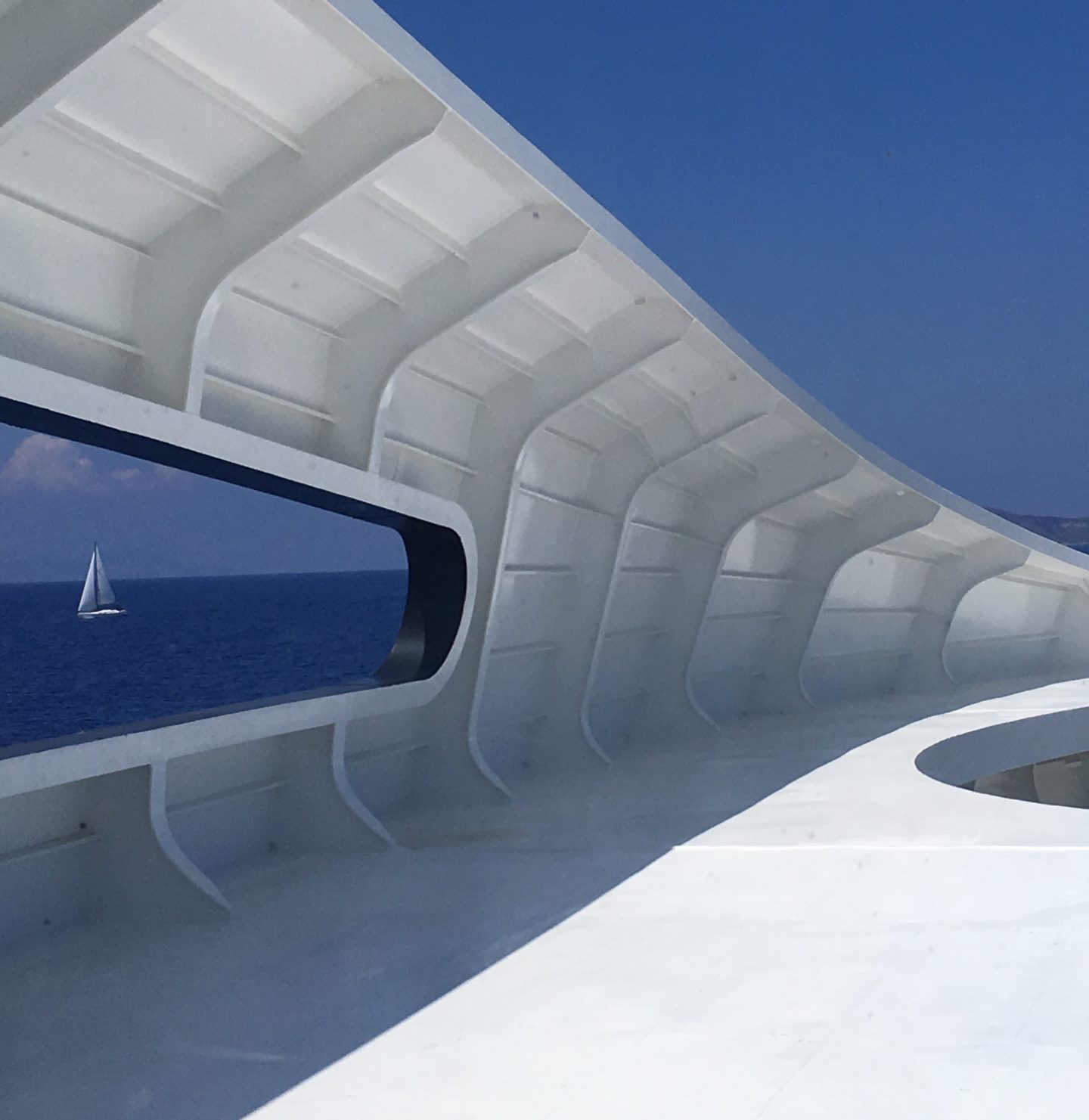
The inter-island ferry from Santorini to Paros (source – Pulped Travel)
There are a couple of things to note when selecting which ferries to use. These issues (relating to the route, the operator, cost and frequency) will affect which ferry you can take to the islands you wish to visit. For example, the larger islands of Mykonos, Santorini, Naxos and Paros are visited daily in the high season by ferries that either depart from or terminate at Piraeus, but that is not always the same ferry operator; so you might find yourself going out to the islands with one ferry operator and then using different ferry companies to get to the other islands in the Cyclades. It is important to remember that even in the high season, smaller islands in the Cyclades such as Serifos and Sifnos will have a lower frequency of arrivals and departures compared to more popular destinations like Mykonos. To get round this and avoid trying to piece together your trip with the phenomenally complicated timetable, I would advise you simply head to Direct Ferries who will do all the heavy lifting for you and present you with a number of options for the days/islands that you want to visit.
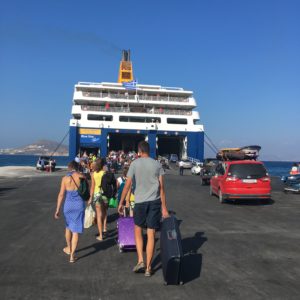
Boarding! (source – Pulped Travel)
The Cyclades are serviced by a mix of high speed vessels and traditional ‘roll on, roll off’ ferries. Both have their advantages and disadvantages, with the high speed boats offering a quicker journey, but less space on board for you and your luggage. The roll on, roll off ferries although larger and more spacious, take longer to reach their destination. It is also important to take into consideration that the ferry operators also offer a different quality of service too with (in my humble opinion) Minoan Lines and Hellenic Seaways offering the greatest comfort, followed by Blue Star Ferries, SeaJets and Golden Star Ferries close behind.
Using the ferries is really straightforward. Aim to be at the port an hour before departure. It is essential that you have your tickets with you before departure. These can be printed off at most travel agents throughout the Cyclades without charge. I would recommend you do this the day before you travel as the queues, on the day, at the port for tickets can be long and may cause you to miss the boat! A number of the operators (such as Hellenic Seaways) allow you to completely bypass this by checking in online and allowing you to receive your tickets on your mobile which you simply show on boarding. And, boy…boarding is QUICK! You need to get on as soon as you are allowed by the crew as these boats wait for no-one. They run to a tight schedule and both boarding and disembarkation will require you to have your wits about you as you either place your luggage in the correct space for departure or find your luggage on your arrival at the destination. All in all, it is great fun, though…if a little hectic!
I find the ferries are an adventure on their own and make for a great start to your trip and arrival onto these wonderful islands!
TRANSPORT ON THE ISLANDS
Getting to and from the port (on your chosen island) to your accommodation may involve a short walk with your luggage, but more often than not you will find that if you have booked your accommodation in advance, someone from the property will be waiting for you to transfer you by car or minivan. This will, however require you to alert them in advance of the ferry that you are due to arrive on and at what time you are arriving. Most will offer this for free, some will charge and some won’t even offer, but it is always worth asking, especially if your accommodation is far from the port.
Getting round the Cycladian island you are staying on is a must! As it is likely you will be staying in or near a town much of this can be done on foot. Just be aware that the pavements can be uneven in places and slippery when wet. If you want to explore further afield, public buses are relatively cheap, costing a couple of Euros for a single journey. Taxis are also available on the islands, but there won’t be many. For example on the island of Mykonos they are scarce and expensive, even for short journeys. The best way to see the islands is to rent a vehicle, whether that be a moped, quad bike or car. All three are great fun and offer you the flexibility and freedom to visit wherever you want, when you want, with whoever you want. Pooling together for a car, for example, can make it a very cost-effective way to see the islands.
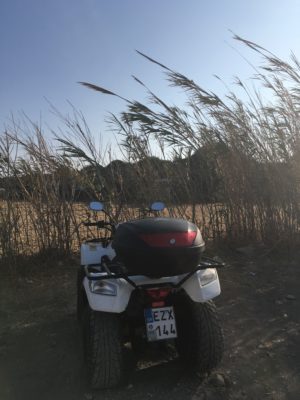
Quad biking around Paros was the BEST fun! (source – Pulped Travel)
ACCOMMODATION
The Cyclades offers a number of different options when it comes to choosing accommodation. Though, of all the places I have visited across Greece, the accommodation on these islands is of the highest standard I have seen and experienced. Therefore, booking in advance is essential during the high season to secure the best quality accommodation at a reasonable price. The islands of Mykonos and Santorini have the costliest accommodation in the Cyclades, so the best value accommodation sells months in advance for the high season. I was amazed to find a wonderful place to stay, in our price range during July, in the main town of Fira on Santorini six months in advance of our stay; such is the demand for good quality, value accommodation on popular islands like these rarely hangs around for long.
I always book accommodation using a range of accommodation providers via Quidco; a cash back site that enables me to ‘earn’ a percentage of what I have paid for the apartment or hotel back – so ‘free’ money for a purchase I was making anyway! If you are planning to visit a number of islands you will want to refer to the ferry timetables first at Direct Ferries (as mentioned above) before booking accommodation as the islands do not always receive a daily service from the other islands they are connected to, so I would advise booking the ferries first and accommodation immediately after. It is also vital you read the reviews and get an idea where the place you are planning to stay is in relation to the main town. Doing so could have an enormous impact on your stay – either for the best, or…the worst!
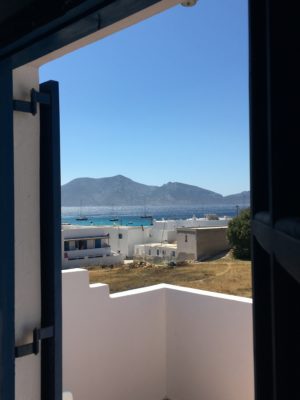
Balcony views in Koufonisia (source – Pulped Travel)
FOOD
Greek food is delicious! You will find the freshest fish, bountiful seafood, excellent grilled meats and all the traditional dishes you would expect from Greece on a visit to the Cyclades. I could write a whole article on the food you can eat in Greece, but I’m going to focus on a few of my faves!
Number one, at the top of the list, has to be the humble gyros. You can find these grilled meats, wrapped in a pita with tomato, lettuce, tzatziki and chips throughout the Cyclades. On islands, like Mykonos and Santorini, where dining out can be an expensive affair, gyros are a cheap and filling way to avoid you blowing the budget, costing around €2.00 depending on which filling you go for. And, the best accompaniment to a packed gyros is a cold Mythos beer!
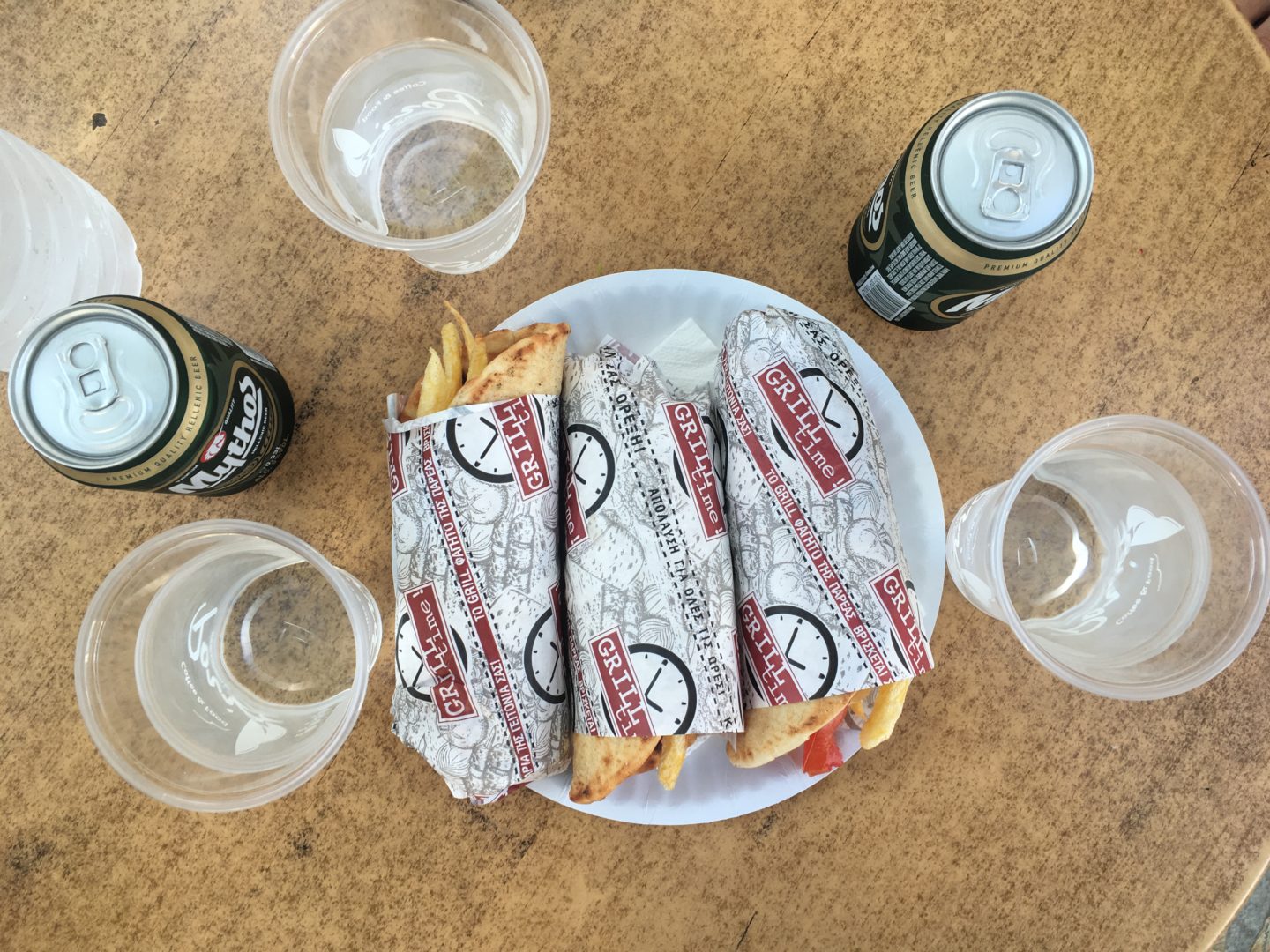
Make sure you visit the bakery or foúrnos (φούρνος) when you are in Greece. They are the mainstay in every village or town and are often the hub for the locals to get their iced coffees and the older residents to catch up on all the news. In addition to a range of beautiful breads and tempting desserts, they make excellent pastries that you can take with you to the beach or on long ferry journeys. Go for the feta-filled filo pastry wrapped cheese pie or tyropita (τυρóπιτα); they are absolutely amazing or spinach version – spanakopita (σπανακόπιτα)!
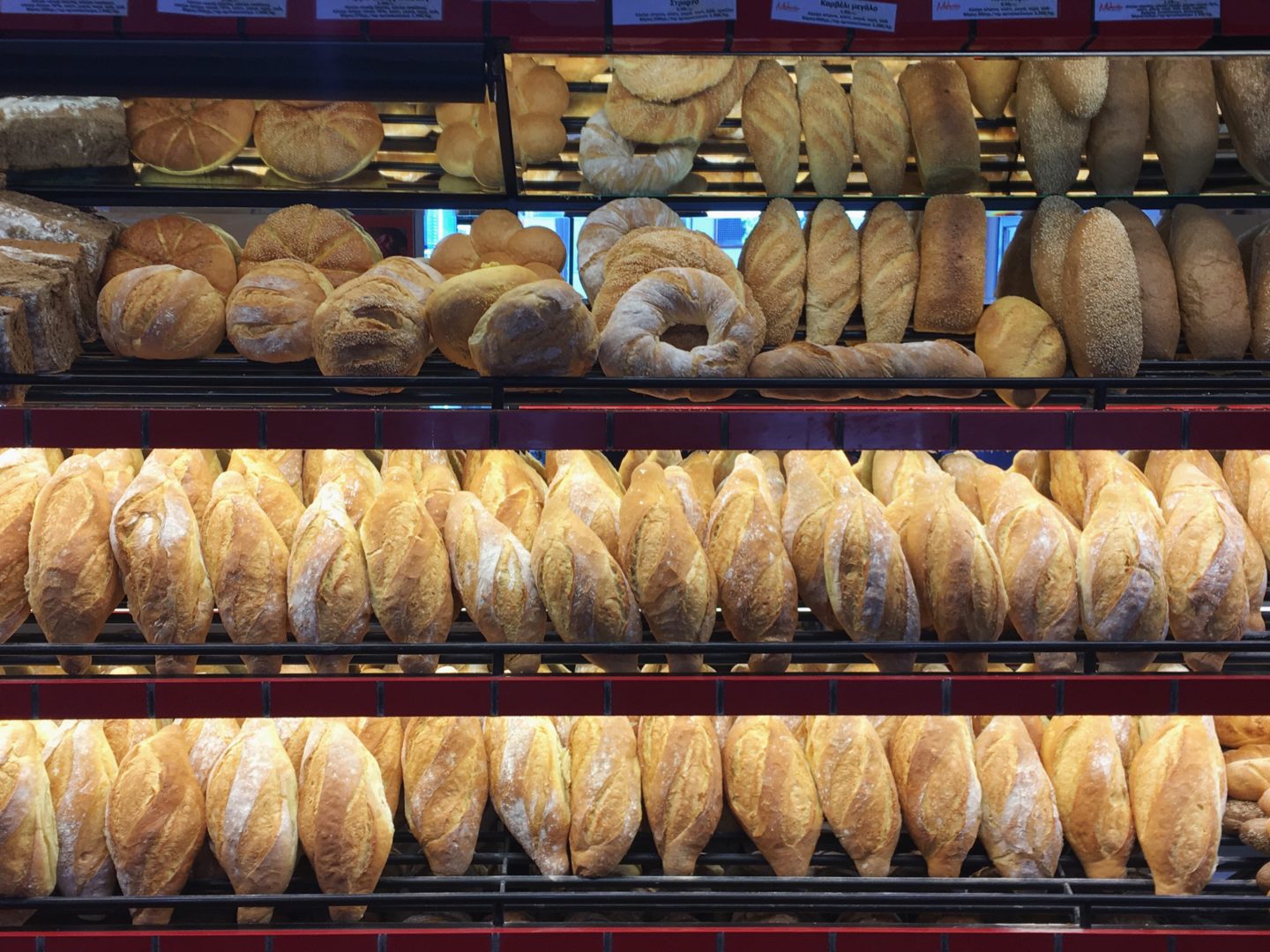
One well-stocked bakery! (source – Pulped Travel)
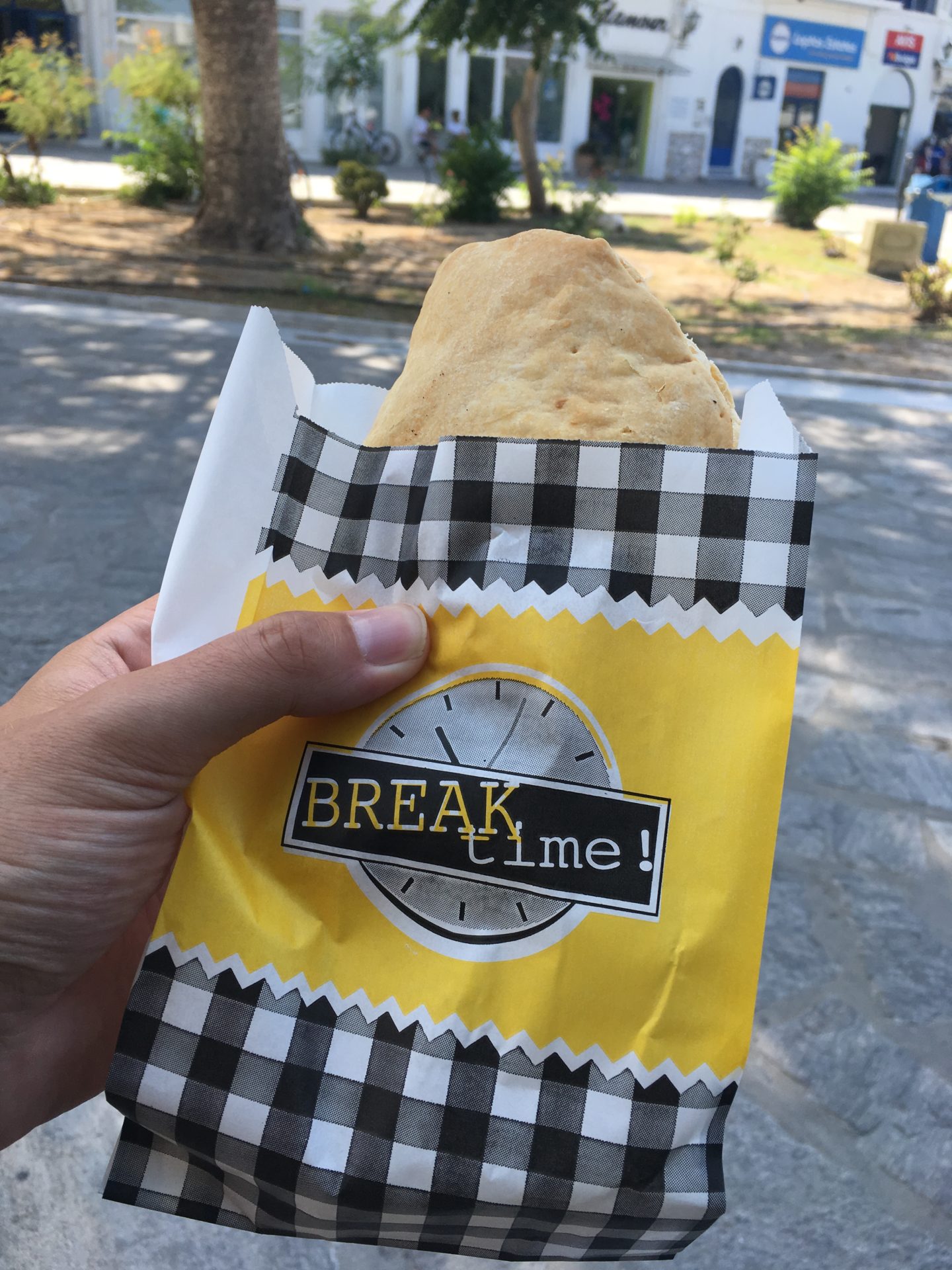
Delicious tyropita! (source – Pulped Travel)
GENERAL ADVICE
Go Greek!
As regular readers of Pulped Travel will know, I am a huge advocate of using some of the local language when you are visiting a country – (Parlez-vous français? ¿Habla español? Parlo italiano? (AKA Mind Your Language)). Being a relatively small nation, the Greeks take great pleasure in foreigners using the language they are immensely proud of. A few pleasantries go a long way in Greece. Check out my quick guide to Greek below:
Hello! – Yas-sas (Γειά σας!)
Yes – Nay (Ναί)
No – Oh-kee (Οχι)
Thank you! – Ef-hari-sto (Ευχαριστώ!)
Please – para-kal-o (Παρακαλώ)
The bill, please! – Toh log-ar-ee-as-mos, para-kal-o (το λογαριασμό παρακαλώ)
Goodbye! – And-ee-o (Αντίο)
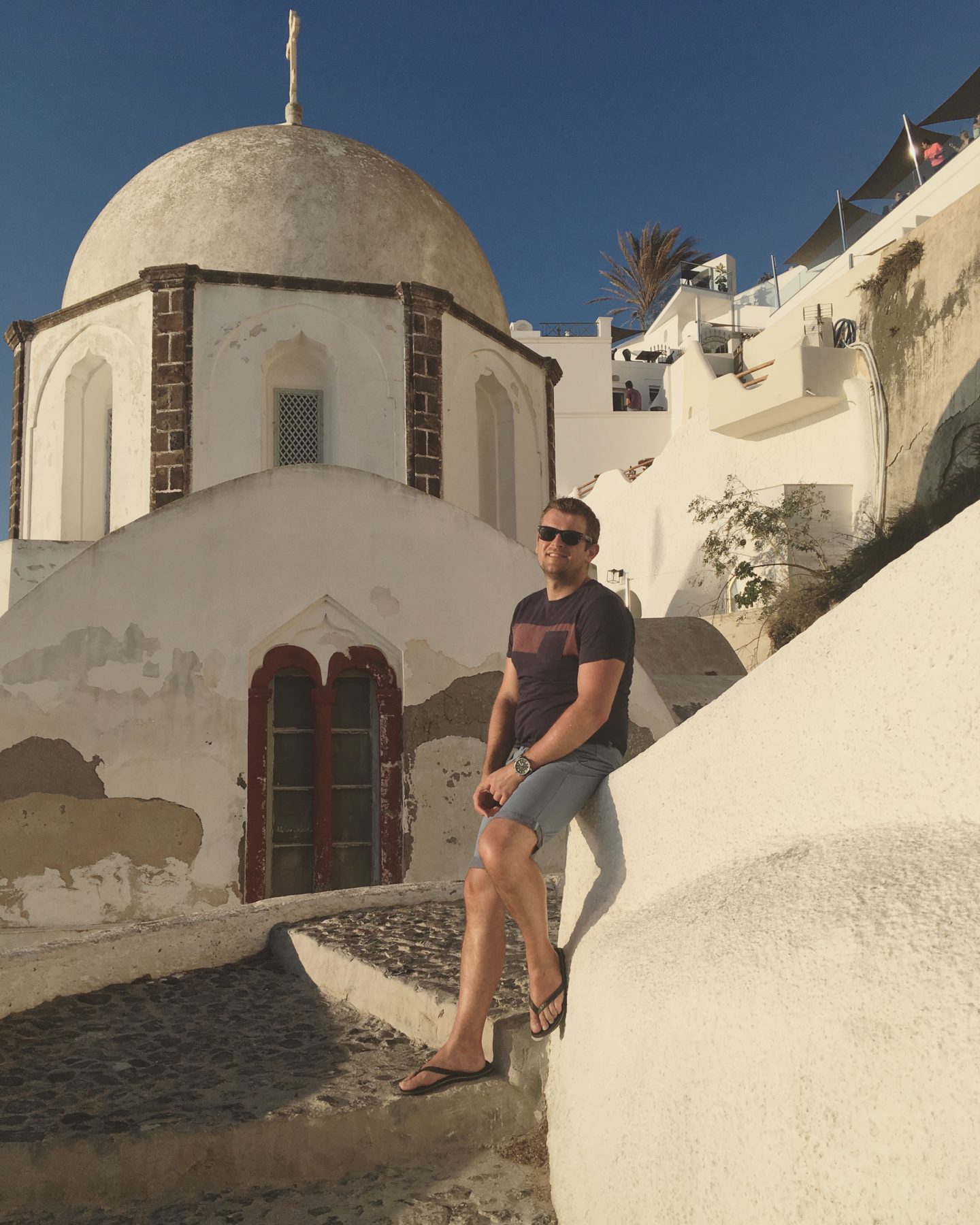
Γειά σας from Santorini! (source – Pulped Travel)
Go Undercover!
Greece is a hot destination…and, I’m not talking about how popular it is right now! No…Greece is just scorching hot! With temperatures reaching the mid-30s in the high season, you are going to need some shelter whether you are lounging by the pool or at the beach. Buying a parasol might be a good idea, but I can recommend getting your shade from a beach tent. Neso make an excellent range that fold up small enough to fit into your luggage and, thanks to the weights, won’t get blown away by those Meltemi winds!
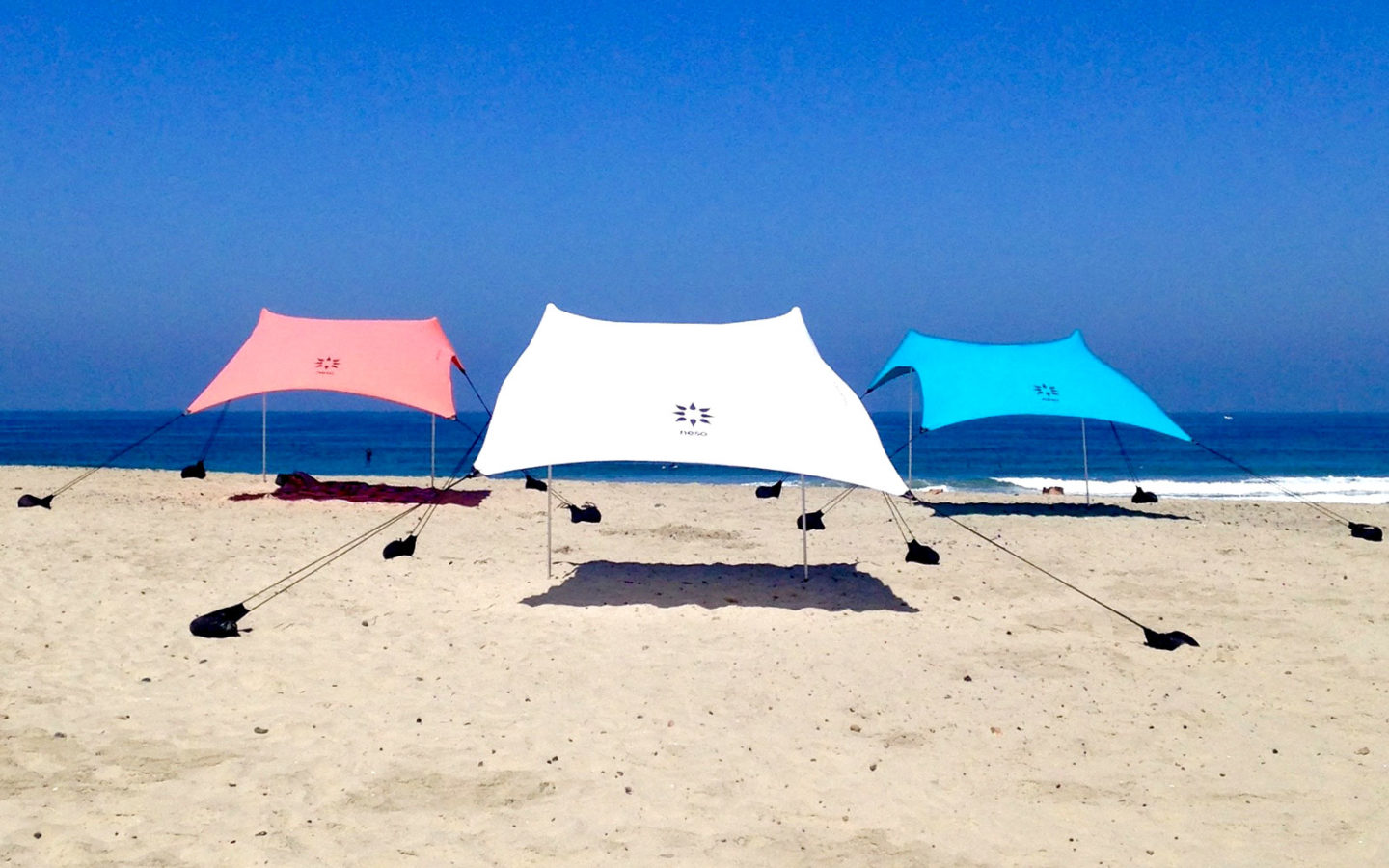
Shady! (source – Neso)
Go Mobile!
The advent of mobile technology has made trips across the world so much easier – (Travel Technology – The Good, The Bad and The Ugly). Having a mobile in Greece is a very useful tool to navigate with, check in for your ferry and tell the people where you are staying at next what time your ferry is arriving. Oh…yeah…it’s great for taking all those photos for Instagram too!
Go Slow!
Don’t make the mistake of packing too much in to your visit, because all you will see is the inside of a ferry as you move from one island to another. I firmly believe Greece is there to be savoured; a relaxing destination for you to soak up the sun, atmosphere and yourself in the warm turquoise waters of the Aegean. Some larger islands, such as Paros and Naxos, deserve a week, at the very least, but there’s no reason why you can’t spend a week soaking up the sights and sandy beaches on a smaller island such as Koufonisia or Antiparos.
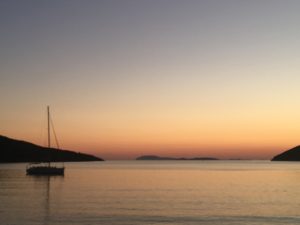
Sunset over Amorgos (source – Pulped Travel)
Go Light!
I would suggest that you try to travel as light as possible if you are visiting more than two islands. A suitcase that you can carry on to the plane will not only reduce your luggage costs, making your flight cheaper but also help with moving from island to island, saving you having to lug your bag on and off the ferries as you move from place to place. I know for some people this may be a deal breaker, but Greece (especially away from the glamour of Mykonos and Santorini) is a swimwear, shorts and t-shirts kind of destination; where a simpler way of life rules. So, why burden yourself with a big bag?
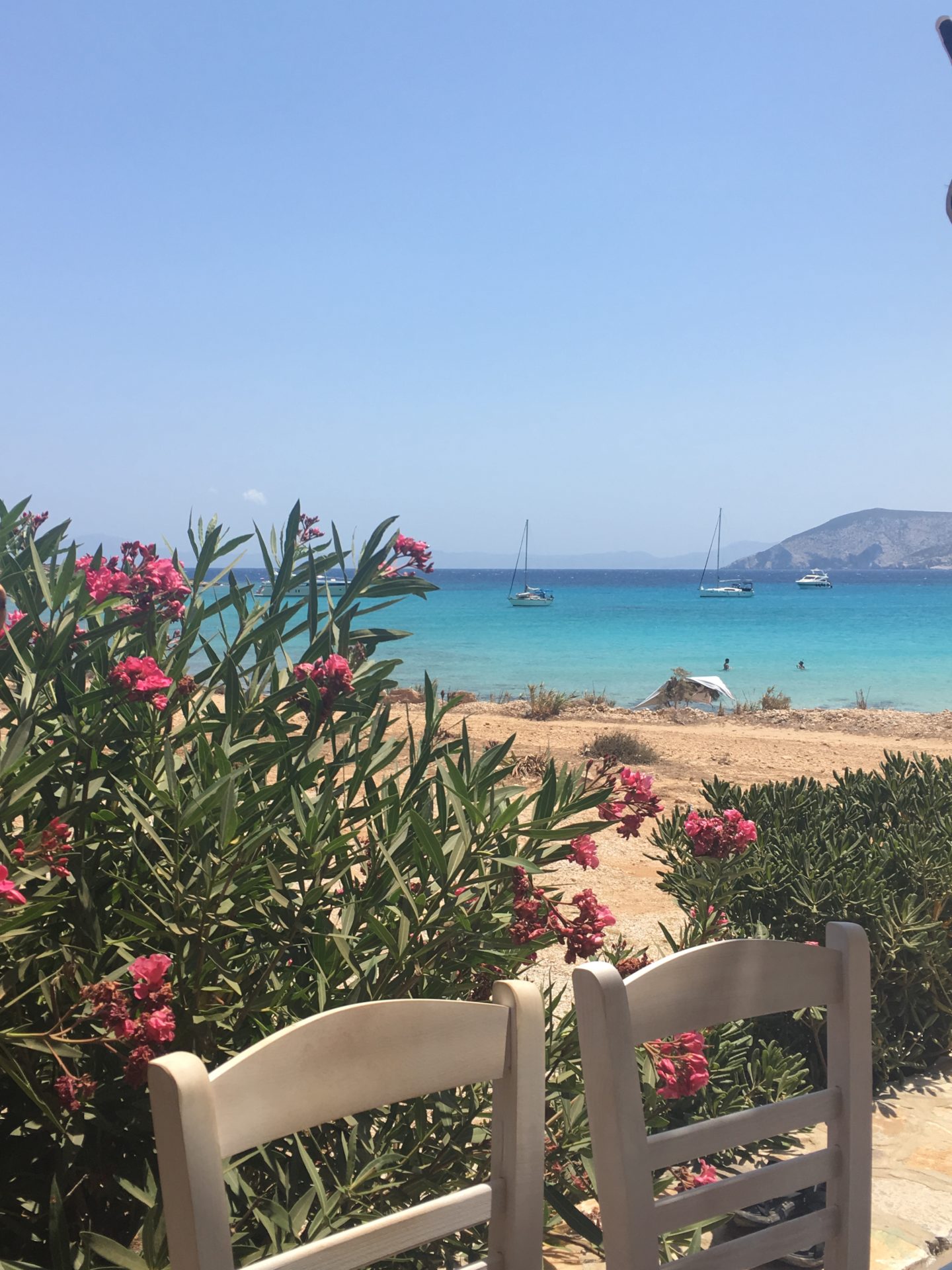
That’s it! I hope this guide has, in some way, helped you plan and organise your trip to the Cyclades. I guarantee you will not be disappointed by one of the most amazing places in the world.
Check out Pulped Travel’s guide to the islands of the Cyclades, featuring…Mykonos, Santorini, Naxos, Paros, Amorgos and Koufonisia.
©Pulped Travel 2018. All rights reserved.
This article contains affiliate links, which means Pulped Travel may earn a small commission if a reader clicks through and makes a purchase (at no cost to the reader). Pulped Travel is independent and is in no way influenced by any advertiser or commercial interest. The links are powered by Skimlinks. By clicking on an affiliate link, you accept that Skimlinks cookies will be set. Pulped Travel’s Privacy Policy.British Airways

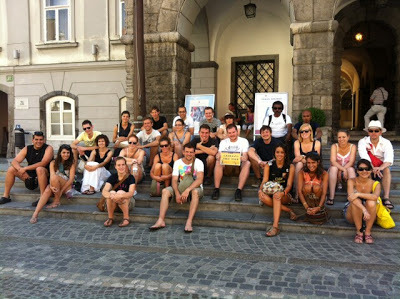
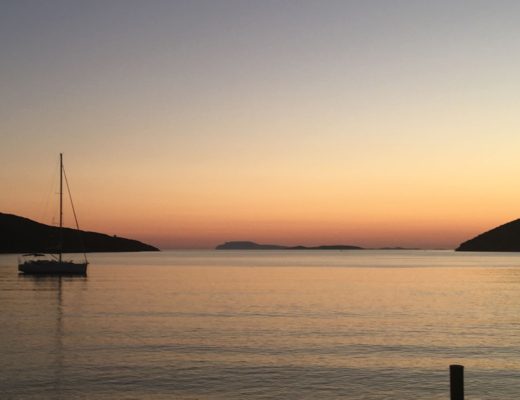
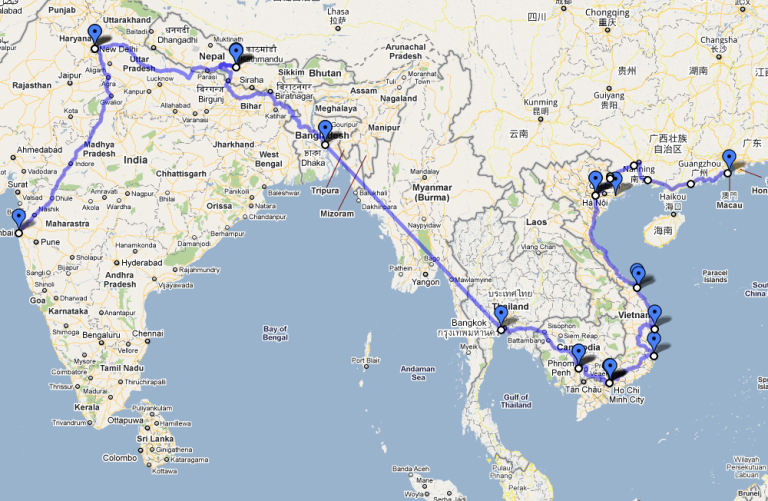
12 Comments
Eddy Webb
21/08/2018 at 9:31 pmHow true and well you have put together beautifully!!!, about the Greek islands. Well done 😊 Love Mum & Dad XX ps dad & I enjoyed our island hopping holiday this year in Greece on five different islands with you, and all where beautiful X
Ed
22/08/2018 at 6:00 pmAwesome! I cannot wait to read more guides about the Cyclades!
A recommended route map would be very ideal, please!
pulpedtravel@gmail.com
22/08/2018 at 6:06 pmThank you, Ed! Keep your eyes peeled!
As for a route map…it really is up to the individual. The islands are so easy to navigate, using the inter-island ferries, a mix and match approach based on personal preference is the best way. I don’t like to be didactic and tell people where to go and what path to follow, but as a rule (and as you’ll find out from the island posts), Mykonos and Santorini are the busier, glitzier…and costlier siblings of islands like Naxos and Paros, where life is much more sedate and life there is all about the beach and traditional Greek food. Some people prefer one to the other, but there’s no reason why you can’t mix them up with an arrival on Santorini, followed by a visit to Koufonisia and Paros. Or simply, avoid these glamazon islands and keep it low key on islands like Syros and Milos. The Cyclades are your oyster!
Jayne & Benji
22/08/2018 at 6:04 pmAbsolutely brilliant, great info and wonderful pictures! I can see some great adventures island hopping. Thanks pulped travel.
pulpedtravel@gmail.com
22/08/2018 at 6:29 pmThank you, Jayne&Benji! You would absolutely love these islands…and the food! It’s all incredible!
Emily
22/08/2018 at 10:19 pmA fantastically written account of such a beautiful place. The level of detail is an outstanding guide for anyone wanting to travel to this part of the world. Keep on travelling, typing and tipping! 💪🏻👍🏻
pulpedtravel@gmail.com
22/08/2018 at 10:21 pmThank you, Emily! That’s really kind of you! I most certainly will! 😀
Wetravelwhere_
25/08/2018 at 11:17 pmLove this article. As half Greek i can totally relate 😍😍😍
pulpedtravel@gmail.com
25/08/2018 at 11:25 pmReally pleased to hear the article had so much you could see in your own life! Ευχαριστώ!
Jenni
23/11/2018 at 6:46 pmGreat guide, feeling inspired:)
Erin
05/01/2019 at 9:36 pmThank you for this amazing article! Greece is definitely on my bucket list and this advice is so helpful for planning the trip! Thank you!
John
11/09/2022 at 12:58 pmThanks,Pulp Travel,
My wife and I are going on our first Island hop next May,for the first time,and you explained your experiences very well.
Our proposed itinerary was to spend a few nights in Athens and then get a ferry and ‘ Hop ‘for 4/6 weeks.
Will you keep you and everyone our experiences.